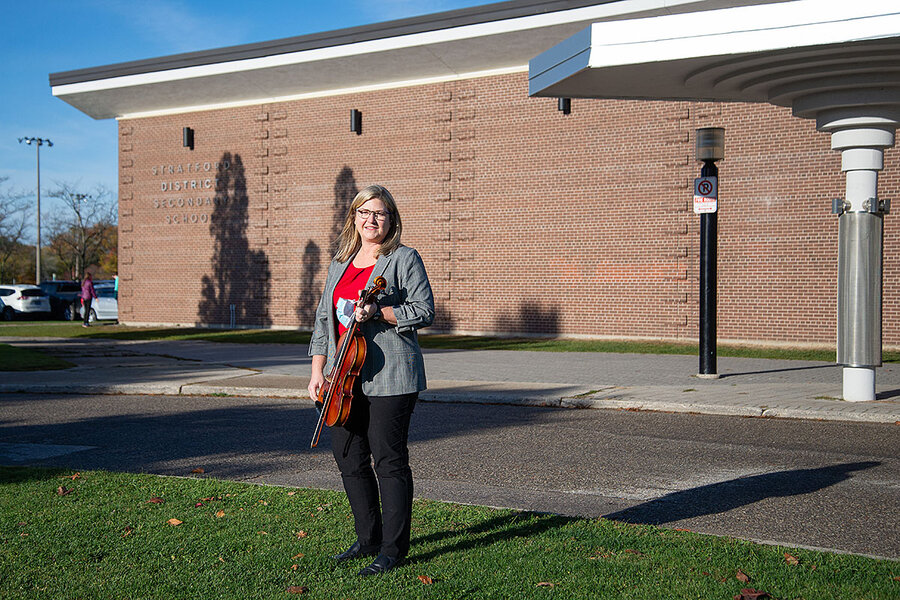Music class during coronavirus: How the band plays on
Loading...
| Toronto
Among the many things the pandemic has disrupted are school music programs across North America. They were in jeopardy after experts linked singing in a choir with several coronavirus outbreaks in Europe and the United States, and a study found that playing wind instruments could be a risk.
Anxious to reopen cautiously, officials at a high school in Stratford, a city in southwestern Ontario, banned wind instruments such as flute, clarinet, and trombone, and allowed singing only if students were outdoors and nine feet apart.
Why We Wrote This
What does perseverance during a pandemic look like for educators? In Ontario, music teachers are finding ways to hold chorus and band classes – even when their students can’t sing or play.
Teacher Paula Ortelli was determined to make things work. In her classroom, physically distanced students learn folk, art, and modern songs by humming and chanting while wearing face masks. After school, they record themselves singing and play the recording in class for feedback.
Even with all the constraints, Ms. Ortelli says hands-on learning is valuable. “Being in the classroom is extremely beneficial to our students,” she says. “It brings them humanity, a human interaction with their teacher and their peers.”
Choral student Jarika Archer agrees. “When I’m singing alone in my room it calms my nerves, and I like the one-on-one time with the teachers,” she says. “So, when I come here, I feel joy, I feel happiness. It makes me feel better as a person.”
Just a week before the new school year started, Paula Ortelli finally learned she’d be allowed to teach hands-on, in-person music classes, but with some important caveats. Anxious to prevent the spread of the coronavirus, school board and health officials had banned wind instruments such as flute, clarinet, trombone, and trumpet from school property. Singing was allowed, but only outdoors and only if students stood at least nine feet apart.
“I understood why, because of COVID, but it’s almost impossible to be that far away from each other,” says Ms. Ortelli, a veteran music teacher at Stratford District Secondary School, a high school in Stratford, Ontario, a two-hour drive west of Toronto.
Ever the optimist, she vowed to find a way to make things work. In her classroom, physically distanced students learn folk, art, and modern songs by humming and chanting while wearing face masks. After school, they record themselves singing at home and later play the recording in class for feedback.
Why We Wrote This
What does perseverance during a pandemic look like for educators? In Ontario, music teachers are finding ways to hold chorus and band classes – even when their students can’t sing or play.
Ms. Ortelli admits it’s not ideal. Her mouth is also hidden behind a mask, so she can’t demonstrate proper vocal technique. Without singing in class, students will find it harder to develop their voices. And since students can’t hear each other, four-part harmonies are off the agenda.
Even with all the constraints, Ms. Ortelli says hands-on learning is so valuable that even a little is better than nothing at all.
“We could do this online, but being in the classroom is extremely beneficial to our students,” she says. “It brings them humanity, a human interaction with their teacher and their peers, and they realize that other teenagers go through the same problems they do.”
Although hands-on music classes have long been part of the public high school curriculum in most jurisdictions in Canada, those programs were placed in jeopardy shortly after the pandemic started in the spring. Experts linked singing in a choir with several coronavirus outbreaks in Europe and the United States. A study from the University of Colorado found that playing wind instruments could be a risk.
Armed with those studies, Canadian health officials banned singing and playing wind instruments in schools, effectively ending many music programs. Music teachers, however, spent the summer devising ways to convince education ministers to put the classes back on the curriculum.
The Coalition for Music Education in Canada leads the campaign. Its chair, Eric Favaro, says he wrote to every education and health minister in the country, arguing that music classes were vital to students’ mental health. He cited examples from around the world of people using song as an antidote to the stress and anxiety caused by the pandemic, and argued it would be especially helpful for children.
“We felt very strongly against students coming back to school and just doing reading and math, science and social studies,” he says. “We said we know their health and well-being has been affected by the fact they haven’t been in school, and one of the best ways to bring them back from those challenges would be to include creative subjects like music and art.”
Mr. Favaro made a convincing argument. Most jurisdictions agreed to maintain their music programs when school returned.
Even before the pandemic, access to music and arts education in public schools in Canada was often tied to demographics and social status. In the province of Ontario, according to the group People for Education, urban elementary and secondary schools are more likely to have a specialist music teacher than schools in rural areas. The group’s 2018 report also found that access largely depends on parents’ ability to raise funds to purchase resources such as instruments and computer software. Schools in wealthier neighborhoods or with a higher number of university-educated parents generally raise more money and have more robust music programs.
Tony Leong, who teaches string ensembles at Dr. Norman Bethune Collegiate Institute in an ethnically diverse suburb of Toronto, says he considers himself fortunate to teach at a school with ample resources.
His school provides each student with his or her own instrument throughout the semester. But pandemic restrictions mean students can’t take their instruments home. Hands-on classes could only go ahead if each student had two instruments – one for school and one to practice on at home. Mr. Leong borrowed the instruments from an elementary school down the road that had canceled its music classes this year.
Now, he says his big challenge is learning new technology that will help students take their music to a higher level even when they’re learning online, where part of his class takes place. “It feels like it’s my first year teaching,” says Mr. Leong, a 20-year veteran.
In Orillia, Ontario, Laura Lee Matthie, who teaches ninth graders, says that with pandemic restrictions in place, it would be easy to focus on theory and written work. But, she says “that’s not what music is.” She’s determined her students will get the hands-on learning they crave. To make sure that happens, she has completely revamped most of the materials she has relied on for years.
“It’s a total shift for your program, so it’s quite a big deal,” says Ms. Matthie, who teaches instrumental band class in Orillia, a small city a 90-mile drive north of Toronto. “You really have to think about how you’re going to plan your day.”
She’s replaced wind instruments with ukuleles and percussion, such as xylophones, glockenspiels, chimes, and boom whackers, colored tubes used to play scales. To accommodate the new instruments, she spends extra time writing her own arrangements adapted for percussion and ukulele. Students take their lessons home to practice. To keep groups separate, students spend an entire week in one classroom studying the same subject, so another challenge has been figuring out how to keep them engaged, which Ms. Matthie does with pop culture quizzes, guessing games, bingo, and frequent walks around the schoolyard.
She says the downside for students is that they aren’t learning the intricate mechanics and finger work required to play most wind instruments. The upside, she says, is that all that drumming is teaching them great rhythm.
“You build the community with the students as they’re working together as a team to build a piece, to share their music,” she says. “The more layers you add to a song, the more interesting it becomes. And it’s just neat to see that unfold with the students, where you can’t do that on paper.”
Jarika Archer, who’s 16 and studying choral music with Ms. Ortelli, says online learning when the pandemic started was stressful for her and her friends, and she’s grateful to be back in class.
“When I’m singing alone in my room it calms my nerves, and I like the one-on-one time with the teachers.” she says. “So when I come here, I feel joy, I feel happiness. It makes me feel better as a person.”
Editor’s note: As a public service, we have removed our paywall for all pandemic-related stories.








